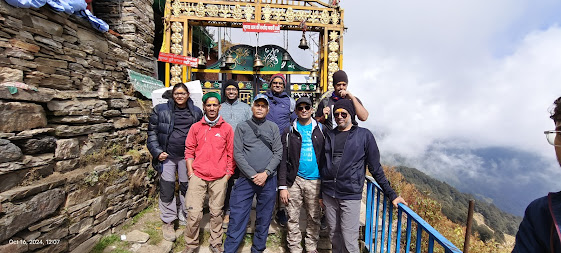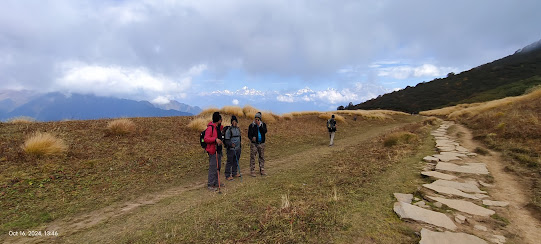Those who have traveled to Sabarimala know the significance of kanni swami. At some point in time, for some strange reason, we ended up giving the nickname of Kanni Swami to Anup, our trek lead. And this name stuck as though it was made for him, and most of us started referring to him among ourselves as Kanni swami!
Last night, Kanni swami had warned us that the distance from Lyuti Bugyal to Rudranath temple was around 10 kilometers one way. We had to reach the temple by 12 noon as the temple would remain closed from 12 noon to 3 PM for mid-noon puja, bhog, and other routine internal matters.
On average, a city-bred person, if reasonably fit and if used to physical activity, can cover about a kilometer in half an hour in a hilly area, mainly comprising climbing up the hill. If this climb up the hill happens to be towards Rudranath temple from Lyuti Bugyal, one has to factor in the increase in altitude, which would cover a place called Pitra Dhar, which at 11,800 feet is probably the highest point of this trek.
As per these calculations, if we start our walk by 5 AM, other things remaining constant, we can hope to reach Rudranath temple by 11/11:30 AM.
Following Kanni swami's instructions as to the huge distance we had to cover and the other factors mentioned, M.S. Subbulakshmi's sweet voice woke us up at 4:15 AM. We were planning to start the trek by 5 AM. The 45 minutes was required to remove the innermost layer (thermal) of multiple layers which we had put on to tackle the night temperature, re-layer the other clothes for the start of the day's trek with torch lights, a show of cleaning ourselves at this blessed time (4:30/4:45 AM) (some of us may have brushed our teeth—I don't remember doing so), remove the woolen socks and replace them with normal walking socks, repack the bags with the thermals and woolen socks, put on the trekking boots, and then start...
By now, it was 5:15 AM when we actually switched on our torch lights and started the trek. The illumination along the path for the first 40 minutes was courtesy of torch lights/headlamps. The sun then rose, and our torch lights returned to the bags, allowing free movement of head/hand depending on whether one had a headlight/handheld torch light.
Most of us did not bother to have our mobile cameras handy. Taking any photo in the dark seemed out of the question, and it probably remained this way for most of our onward journey, till we reached Rudranath.
In the initial stages of the walk itself, we could feel the altitude gain, making it slightly difficult to breathe at places.
In some time, we reached Pannar Bugyal (which we were told, earlier used to be a military camp). Vast plains and stunning meadows greeted one's eyes when we reached this point. Needless to say, these vast plains, surrounded by the majestic Himalayas on all sides, looked serene and picturesque. But given that we reached here in the early hours of the day, when the temperature would be in single digits, this combined with the wind blowing literally felt like ice cutting through one's body.
I personally saw a group of youngsters taking selfies and making the most of the surroundings. But for us, the target was to reach the temple before it closed at 12 noon. A little way ahead, we could see the path winding spirally into the mountains with a cliff rising majestically on one side, seeming to offer respite and protection against the winds.
Shortly after crossing this point, a couple of our group members found it difficult to proceed ahead, with one offering to return to Lyuti Bugyal. In all probability, AMS—abbreviated for Acute Mountain Sickness, a high-altitude sickness—hit them. Probably the reason being the sudden increase in altitude with the atmosphere getting thinner with lower oxygen levels in the air around us. Kanni Swami made a couple of phone calls and arranged for a couple of mules to ensure further transportation for these two members.
When he inquired whether anyone else required this alternate transportation, two more members, including me, unabashedly consented to mules. However, despite half an hour's wait, nothing turned up. Anup instructed us to keep proceeding towards the destination and get on the mules if and when we managed to procure one.
As we kept plodding along, we reached Pitra Dhar, a scenic spot from where the valley below looked like a huge sphere. This spot, I was later informed, was at a height of 11,800 feet above sea level, most certainly the highest point of the trek.
After this, the trail took a descending turn, which made our walking speed slightly faster. The other members of the group, except the two who had taken mules, must have reached far ahead of us, as we lost precious half an hour waiting for the mules.
By now, it was almost 10:45 AM, and Kanni Swami started egging me and my partner, who still were longing for a mule, to speed up our pace, else the temple may close, and this would mean waiting for another three hours to have darshan or to start our return without having darshan.
At this point, I was thankful for the regular walks and runs myself and my partner were used to. As a result, we literally ran the last 45 minutes to reach Mahadev Rudranath's temple by 11:45 AM.
The walk since 5:15 AM, expecting a mule ride but not getting it, running the last 45 minutes, and the hours and hours of walking and jogging which we did before starting the trek—each second of these was worth it when we spent the five minutes sitting close to Him, before Him, getting His divine Drishti on us.
As informed by Anup, the temple shut at 12 noon sharp, with the Panditji assisted by the internal staff offering bhog to Mahadev.
We had a group photo outside the temple immediately after the darshan. Anup had arranged lunch at a local stall. Immediately after lunch, we started our return journey. Now that the darshan was over, and that all of us managed it before 12 noon, personally, I hoped to get some good photos in my mobile camera on my return journey.
Anup warned us not to spend too much time over these trivialities and reminded us about the long walk back. It had taken some of us over six hours (5:15 to 11:30) one way. It was 1:00 PM noon. Sunset would be around 6:00 PM, which meant, if we are not hurrying up now, we may end up having an hour's journey remaining after sunset, which would make it extremely difficult to negotiate.
The two who had taken mules on the onward journey boarded their animals and left. Others who could walk fast started walking at their pace. Remaining ones with Anup for company walked as fast as possible without tiring their bodies too much.
Vishagan had managed some raw rice from a stall near the temple. He was planning to offer it to the Pitrus at the Pitra Dhar spot. He offered me a handful, and together we quickly but sincerely offered our obeisance to our forefathers.
Here, I saw a few people dressed colorfully, resting at this spot with a palki. It seems they were waiting here for a few more of their group who would escort the Utsav Murti in this palki and shift it to another temple for six months.
Readers would remember me mentioning in an earlier chapter about the trekking company not bothering to reply when we checked with them why the trek could not be started a day later, say on the 15th of October instead of the 14th. The reason for this was four out of the five Panch Kedar temples close down for six months during the winter season, when the climate becomes very cold and it starts snowing.
The date of temple closure for Rudranathji, whose darshan we had just a few hours back, was scheduled for the next day morning. The Utsav Murti would be placed on a palki and shifted to another specific temple at a lower altitude where regular puja would be conducted on a daily basis. During these six months, it would start snowing, and accessing the temple would become impossible, and hence this arrangement.
We continued our walk. It had started growing dark, and by the time the sun set at around 6 PM, we pulled out our torches and headlights and started our descent. As predicted by Kanni Swami, it took us another hour to reach the base camp, but the last hour of the walk was an experience which I would never forget for the rest of my life. Each of us taking turns in holding the torch and leading the way for 15 to 20 minutes, ensuring that the dark path ahead is lit with enough illumination for them and their fellow trekkers.
We finally reached the camp by 6:45 PM, had the hot dinner that was made available, and plonked down at our beds. Sleeping experience was the same as the previous night. However, after a very, very tiring day, no one bothered to set the alarm.







No comments:
Post a Comment